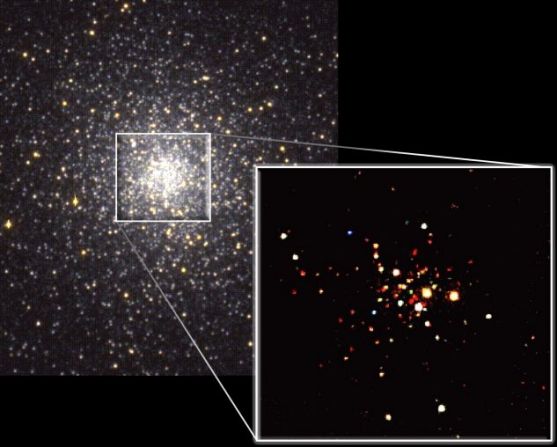
|
Credit: X-Ray: J. Grindlay
(CfA) et al.,
CXO,
NASA
Optical: W. Keel (U. Alabama Tuscaloosa) et al., 1.5-m Telescope, CTIO
Explanation:
A deep optical image (left)
of 47 Tucanae shows an ancient
globular star cluster so dense and crowded that individual stars
can not be distinguished in its closely packed core.
An
x-ray image of its central regions (inset right) from the
Chandra
Observatory reveals a wealth of x-ray stars hidden there.
Color-coded by energy, low energies are red, medium green,
and high energy cosmic
x-ray sources are blue, while
whitish sources are bright across the x-ray energy bands.
The x-ray stars here are double stars or "compact"
binary star systems.
They are so called because one of the pair of stellar companions is
a normal star and the other a compact object --
a white dwarf,
neutron star,
or possibly a black hole.
Chandra's
x-ray vision detects the presence of
an unexpectedly large number of these exotic star systems
within 47 Tucanae, but it also indicates the apparent
absence of a large central black hole.
The finding suggests that compact binary star systems of
47 Tucanae
may be ejected from the cluster before coalescing
to form a large black hole at its core.
Optical: W. Keel (U. Alabama Tuscaloosa) et al., 1.5-m Telescope, CTIO
|
January February March April May June July August September October November December |
| ||||||||||||||||||||||||||||||||||||||||||||||||
NASA Web Site Statements, Warnings, and Disclaimers
NASA Official: Jay Norris. Specific rights apply.
A service of: LHEA at NASA / GSFC
& Michigan Tech. U.
Based on Astronomy Picture
Of the Day
Publications with keywords: globular cluster - pulsar - neutron star - binary star
Publications with words: globular cluster - pulsar - neutron star - binary star
See also:
